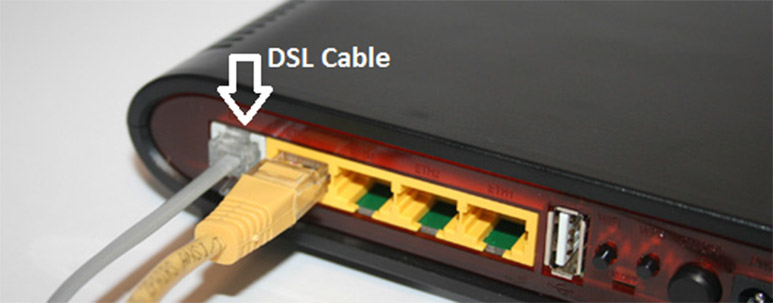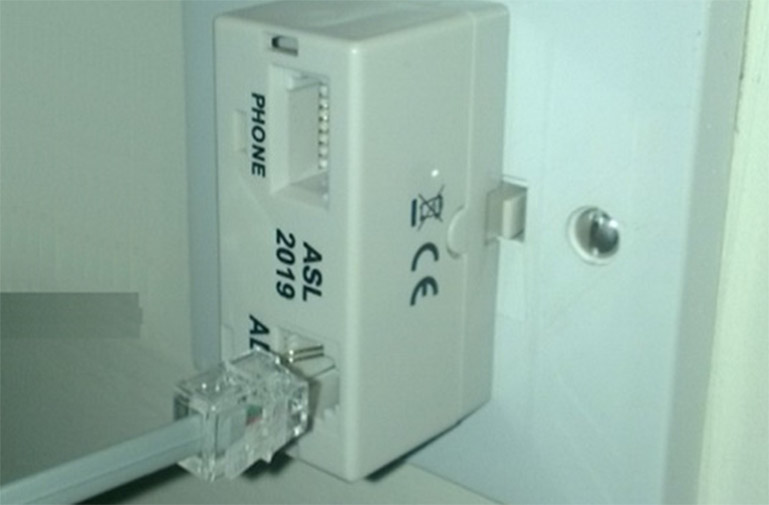Broadband Issues
If you are having trouble with your broadband service, you can check the service status on this website to see if we are having any problems - http://www.timetalk.co.uk/service-status/. If not, the problem may be isolated to you. Below we have included some checks that will help you identify what the problem is.
This section includes;
- Connection drops
- No internet light
- Hardware failure
- Speed issues
- Displaying a webpage
-
1 - Connection Drops
Drops in ADSL synchronization
ADSL synchronisation is basically the connection between your ADSL router and the local telephone exchange. A fault with anything between your premises and the exchange can result in an ADSL synchronization failure. This issue can easily be identified by a flashing DSL light on your router.
So what can you do?
Start at your router. Make sure that all the wires are connected correctly and securely. Then follow the DSL wire from the router, make sure there is no damage to the wire itself.

You will get to the ADSL micro filter that is plugged into the telephone socket in the wall. Replace this with a new one.

If you have found no problems by this point, it is starting to look like the problem might be external. One final check would be to connect your router through your BT test socket and test from there. The test socket is where your BT phone line enters your property. The front plate to this socket will have 2 screws in it. If you remove these screws and slide off the face plate, you will find a test socket. Not all master sockets have a test socket so don't worry if you can't find one. Your main BT socket will be directly connected to the line coming into the property.

Move you router so that it is in range of this socket and a power supply. Don't worry about being able to connect to your PC, that doesn't matter at this point. Connect your equipment the same way as before, but with the micro filter into the test socket. Wait for a couple of minutes to see if the DSL light on your router stops flashing. If it does, you have identified the problem as your internal wiring. It could be a poor connection on the face plate, or damaged/faulty wiring to the extension socket your filter was plugged into.
If the DSL light on your router continues to flash, the problem is looking more external. Nothing beyond that test socket is your responsibility. At this point you should contact our technical support department and have them raise a fault with BT for you. You cannot contact BT directly.
-
2 - No Internet Light
No PPP session
Your PPP session can best be described as your connection to us. A PPP session is started when your broadband username and password have successfully been authenticated by our servers and you have been granted Internet access.
A problem with your PPP session can be identified by a red INET light on your router, or no INET light at all. What should you do?
The only place you need to check is on your router. Follow the initial router setup guide you were provided with making sure all of the routers configuration is correct, paying close attention to the username and passwords you input. **The latest models of routers provided by Supanet will automatically configure themselves when they are connected in a factory default state. You can try power-cycling the router by removing the power cable or turning the power off at the socket. If this doesn't work, there is nothing further to do at your side. Contact our technical support team.
-
3 - Hardware
Hardware failure
What should you do if your hardware fails?
The router you are supplied with comes with a 12 month guarantee. If it stops working within the first 12 months we will replace it for you free of charge*. This guarantee covers hardware failure only. We cannot replace your router free of charge if it has been accidently damaged by improper care.
*A router delivery fee of £14.99 is applicable.
-
4 - Speed
Speed
Broadband speed is probably the top reason of contact for any ISP.
You subscribed for a certain speed but don't achieve it.
This is the reason ISP's use the phrases like "up to 8mb" when advertising services. Under ideal circumstances you can receive an 8mb broadband connection. However, if you live a long way from your exchange, the speed you will actually receive is lower. Without going into details, the further it has to go, the longer it takes. When you contact any ISP they can tell you what speed you are expected to receive.
Speed drops at certain times of day
This is usually caused by contention. The telephone network can only handle so much data at a time. At peak times, when most people are logged on at the same time, it can cause delays in your data being received and slow things down. This type of contention is unavoidable and should be expected with any broadband supplier.
Interference
This is probably one of the most common causes of slow speed for broadband. The copper wire used for your phone line is like one big antenna. If it is not correctly insulated, it can pick of stray electrical signals from all over the place. Data is transmitted through your line in the form of pulses of electricity. These pulses can be drowned out in the background noise on a faulty wire. If this happens, the data may be unreadable when it reaches its destination and needs to be sent again. This can make a simple request like receiving a web page take a very long time. Interference can be caused by many things, including TV's, satellite TV boxes, microwaves, radios, cordless telephones, light switches [including security lights, seasonal lights and dimmers switches], even power showers and central heating systems! Pretty much anything electrical can give off radio interference. To identify if your broadband has interference you can use a simple AM radio, tuning it to around 612 KHz. By listening for variations in the white noise it should help you hunt out the source of the interference.
Download speed
A query we often get is from users who, when they come to download a file, struggle to get over 1MBp/s. But this is perfectly normal. The reason for this is how these data rates are measured.
Your broadband speed is measured in "megabits per second" or "mbp/s". When you are downloading a file, its data rate is measured in "megabytes per second" or "Mbp/s". There are 8 bits to every byte, so the download rate displayed in MBp/s will be 8 times slower that it is displayed in mbp/s.
Speed Tests
Running a Speed Test
If you want to check your speed, or believe there is an issue with your broadband speed, you can run a speedtest from speedtest.btwholesale.com. You should try and complete at least 3 wired speed tests in a 24 hour period [Not using WIFI]. This would be morning, midday and evening. There are many speed test sites available out there, but you must use this one for fault purposes. Once you have your three results, give our technical team a call to discuss if a fault needs to be raised.
-
5 - Displaying Web Pages
Displaying Web Pages
If you are having trouble displaying a particular web page, it is usually being blocked, or looked for in the wrong place.
Supanet will only restrict web access if there is a payment issue on your account so always ensure your account is up to date before attempting any technical troubleshooting.
Some things to consider;
Some antivirus programs come with built in firewalls; it is not difficult to accidently block yourself from a website without knowing. If yours has this feature, try disabling it temporarily and trying again.
Your web browser will have its own security settings to help protect you. Most home PC's should have this at its default level. If you have set it higher, some pages will not load or content might be missing. Try setting this to the default level and try again.
The web site you are trying to visit might be down; you should check this from another PC or device with internet access.
Clearing the cache of saved web pages stored on your PC or powering off your router for a few seconds can also correct other issues with web pages not being displayed.